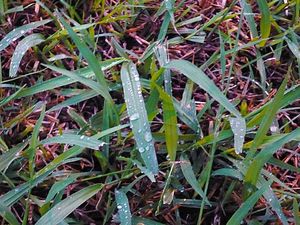The United States Department of Agriculture (USDA) notes that plenty of states classify Johnson grass as a “noxious weed.” Even so, the plant known in botanical circles as Sorghum halepense is widespread. Author C. Neal Stewart, Jr. — in his work “Weedy and Invasive Plant Genomics” — suggests that Johnson grass may have been intentionally sown in American soil for cheap forage, but was eventually found to reduce the yields of sugar cane and soybean harvests. Adding insult to injury, this weed plant is among the types of grass that help lawn pests to overwinter and germinate sufficiently early to out-compete desired lawn grasses for nutrients and sunlight. Does any of this help you to rid your gorgeous landscape of the invasive Johnson grass? Probably not; then again, learning how to get rid of Johnson grass requires a thorough understanding of this hardy and difficult to eradicate weed.
Do I need to move quickly when I first notice Johnson grass?
The answer is a resounding “yes!” Researchers from the Department of Agronomy at the University of Missouri note that just one Johnson grass plant is capable of producing in excess of 80,000 seeds in just one growing season. Add to this the likely production of rhizomes extending approximately 275 feet, and it is clear that swift suppression of the weed is your best bet. Rhizomes can be as deep as five feet beneath the lawn, while seedlings as young as only 19 days already begin forming them. If you miss the boat here, later management becomes time-consuming, costly, and potentially failure-prone.
I missed the boat; can I just spray to get rid of Johnson grass?
While you can most certainly try to spray an herbicide on areas infested with the weed, there is a good chance that this treatment does more harm (to nearby plants) than good. The rhizomes make the grass very difficult to eradicate. If you resort to tilling, be sure to go deep; if you fail to uproot even the deeper rhizomes, you most likely will only aid the plant in spreading.
How to get rid of Johnson grass — permanently
- Mow the grass to prevent the formation of panicles (also known as seed heads). While I have previously told you not to mow too close to the ground, note that this rule does not apply to weeds. The goal is to prevent the formation and spread of seeds. Scalping the plant also weakens its ability to photosynthesize, which results in stunted growth.
- Uproot the rhizomes of weakened plants. The bad news is that the aforementioned process takes about two years to sufficiently weaken the plants. The good news is that the rhizomes may now be just below the soil surface. If unearthed at the onset of frost season, the cold temperature should kill a fair number of plants.
- Revise irrigation patterns. An overage of water and subsequent runoff leads to the disbursement of seeds. If the lawn area is too wet, the growth conditions for Johnson grass are ideal. Curtail the watering and explore ways of adding proper drainage to lower areas of the landscape.
- Treat the lawn with post-emergence herbicides. It catches seedlings before they have a chance to develop deep rhizome networks.
- Renovate the lawn. If all else fails, it might be time to start over. Opt for a lawn grass that is native to your area, which gives the desired plant an edge with respect to nutrient and sunlight competition.
Sources
United States Department of Agriculture; “Sorghum halepense
Weedy and Invasive Plant Genomics
University of Missouri; “Johnsongrass Control”
More by Sylvia Cochran
5 Steps to Cultivating Green Lawns After Dethatching
How to Identify and Eradicate the Types of Weeds Taking Root in Your Lawn Right Now
Buying the Best Types of Grass Seed for Your Lawn Area

